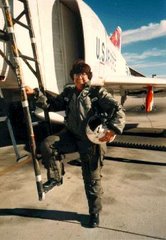I got a very interesting phone call last week and it really was a thrill. It's kind of complicated, so I'll have to start with some background.
Back in 1991 a couple of guys I worked with doing in-flight simulation were Technical Chairman and a Session Chair, respectively, at the AIAA Simulation Science Conference, which was held at the same time and place as the AIAA Guidance, Navigation, and Control and Atmospheric Flight Mechanics Conferences. My husband and I always went to these conferences, which are in August. The guys wanted me to write a paper about in-flight simulation at Dryden. There were two reasons for this, that I'd been managing the in-flight simulation at Dryden for years and that it wouldn't look like an advertisement, since Dryden used the various aircraft, rather than providing the service. I guess I need to mention that the conference TC was the USAF manager of their in-flight simulators and the Session Chair was the department head of the company that operated those aircraft and a couple of their own. You can see where them writing such a paper might not look entirely neutral on the subject.
So I wrote the paper. It took a lot of research and I spent a lot of time up at the Ames Research Center, going through fiches and reading old, old papers. I blew a lot of them back and would have a heavy box to carry back on the KingAir on every trip. I went around and interviewed past and present research test pilots and engineers and generally had a good time, but it was harder to write this paper than it was to turn out a more focused paper on some flight test results. I also spent a lot of time picking out photos so the paper wouldn't be just text.
I gave the paper at the conference (it was in New Orleans that year) and the room was full to overflowing and engineers came up afterward to tell me how much they'd liked it, engineers I knew and respected. As a result, I decided it was a pretty good paper. AIAA couldn't publish it as a journal paper because it was way too long and there was no good way I could cut it down, so I was kind of stuck, looking for a more widely distributed publication method. I happened to talk to Dick Hallion, who was working as a historian for the Air Force Wright Aeronautical Laboratory at the time, about the paper (he'd liked it) and he suggested I try the Journal of the American Aviation Historians Society. Dick had written a very good history of Dryden some years before this, which was when I'd gotten to know him.
So I sent it to the AAHS and they were very happy to publish it for me. I made a few small changes and we sent it off, with a stack of photos, and got back copies of the magazine some time later. They did a beautiful job printing the paper, because they used glossy paper and photos were important to them.
You can read the TM version of the paper, In-Flight Simulation Studies at the NASA Dryden Flight Research Facility, here. It's not very technical and it may be interesting.
OK, that's the background. You can see why I said that you needed it to understand what happened last week.
Dick Hallion is back working for NASA as a historian again. The agency is putting together a four-volume series on NACA/NASA aeronautics research history, aimed at letting the young engineers learn about all the stuff that has been done in aeronautics over the years. Three of the volumes are about aerodynamics and wind tunnels and the fourth volume is about handling and flying qualities and topics like that. At least, I think that's how Dick described it. I may be wrong, though. Dick is in charge of this effort (I think he's a contractor, not that it matters) and he'd remembered my paper all these years and thinks it should be included.
So he called me up to ask me if I'd like to bring it up to date for inclusion in this, because he thinks it's important to include the topic and I'd already written such a good paper, he thought. This is a form of profession immortality, in its way. I'll be a contractor to NASA and I think I'll be able to use the Dryden library and photo lab, as well as having access to the pilots and researchers. So far as I know, there hasn't been a lot of in-flight simulation studies at Dryden since I wrote the paper. Handling and flying qualities research has really dropped off the charts for funding these days, as has aeronautics, at least at NASA (and, I think, the USAF). Aeronautics has kind of been the red-headed step child at NASA once the Space program really started sucking up the funding.
And I get a copy of the four-volume set, too. Plus they pay me, although not a huge amount.
16 February 2009
Subscribe to:
Post Comments (Atom)








2 comments:
Congratulations! That's awesome. (I have this totally armchair fascination with flight.)
Hi--for some reason I can't get the link to work. Is there another one?
Post a Comment